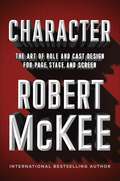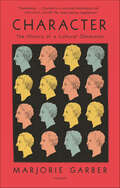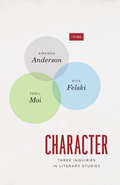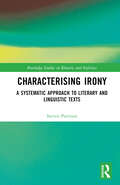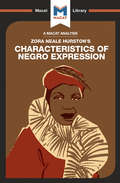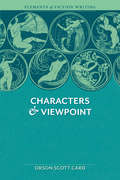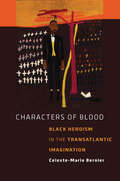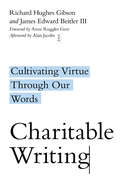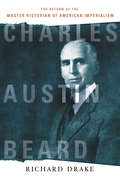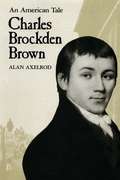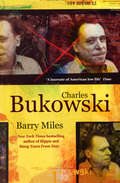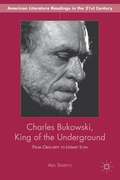- Table View
- List View
Character: The Art of Role and Cast Design for Page, Stage, and Screen
by Robert MckeeThe long-awaited third volume of Robert McKee&’s trilogy on the art of fiction. Following up his perennially bestselling writers' guide Story and his inspiring exploration of the art of verbal action in Dialogue, the most sought-after expert in the storytelling brings his insights to the creation of compelling characters and the design of their casts. CHARACTER explores the design of a character universe: The dimensionality, complexity and arcing of a protagonist, the invention of orbiting major characters, all encircled by a cast of service and supporting roles.
Character: The History of a Cultural Obsession
by Marjorie Garber“In her wide-ranging cultural history of the term [‘character’], Garber has unearthed fascinating material and is a convivial, stimulating critic.” —Michael Saler, The Times Literary SupplementSince at least Aristotle’s time, philosophers, theologians, artists, and scientists have pondered the enigma of human character. Whether defined as a moral idea, a literary persona, or a scientifically observable type, character has become omnipresent in discussions of politics, ethics, gender, morality, and the psyche. In this “magisterial book,” Marjorie Garber examines the evolution and influence of this pervasive concept.Is there a connection between “character” in the moral sense and the “character” of a novel or a play? Can character be “formed” or taught in schools, in scouting, in the home? From Plutarch to John Stuart Mill, from Shakespeare to Darwin, from Theophrastus to Freud, from nineteenth-century phrenology to twenty-first-century brain scans, the search for the sources and components of human character still preoccupies us.With her distinctive verve, humor, and erudition, Marjorie Garber explores the stakes of these conflations, confusions, and heritages, from ancient Greece to the present day.
Character: Three Inquiries in Literary Studies (TRIOS)
by Amanda Anderson Toril Moi Rita FelskiOver the last few decades, character-based criticism has been seen as either naive or obsolete. But now questions of character are attracting renewed interest. Making the case for a broad-based revision of our understanding of character, Character rethinks these questions from the ground up. Is it really necessary to remind literary critics that characters are made up of words? Must we forbid identification with characters? Does character-discussion force critics to embrace humanism and outmoded theories of the subject? Across three chapters, leading scholars Amanda Anderson, Rita Felski, and Toril Moi reimagine and renew literary studies by engaging in a conversation about character. Moi returns to the fundamental theoretical assumptions that convinced literary scholars to stop doing character-criticism, and shows that they cannot hold. Felski turns to the question of identification and draws out its diverse strands, as well as its persistence in academic criticism. Anderson shows that character-criticism illuminates both the moral life of characters, and our understanding of literary form. In offering new perspectives on the question of fictional character, this thought-provoking book makes an important intervention in literary studies.
Characterising Irony: A Systematic Approach to Literary and Linguistic Texts (Routledge Studies in Rhetoric and Stylistics)
by Steven PattisonThis book offers a systematic, bottom-up account of irony across both everyday contexts and literary and linguistic texts, using an empirically rigorous approach in distinguishing between central irony, non-central ironies, and non-ironies and highlighting a new way forward for irony research. The volume considers the current landscape of irony, in which the term is used with increasing frequency with the knock-on effect of a loosening of its meaning. Pattison addresses this challenge by applying a systematic form of analysis, rooted in frameworks from pragmatics and complementary disciplines, to a database of over 500 irony candidates from a wide range of sources. The book uses these examples to illustrate the features of central ironies as well as the attributes used to differentiate between central ironies, non-central ironies, and non-ironies. These attributes are mapped across four key domains, including: difference and opposition; the role of context; how ironies are signaled; and speaker attitude and intention. Taken together, the volume puts forth a credible account for more clearly characterizing examples of irony and equips researchers with a comprehensive step-by-step method for undertaking future research. This book is key reading for scholars in stylistics, pragmatics, literary studies, and psycholinguistics.
Characteristics of Negro Expression
by Benjamin Lempert Mercedes AguirreThe racial prejudices of 1930s America were many, and included a common presumption that African American art was unoriginal – merely poorly copying white culture. African-American novelist, anthropologist and essayist Zora Neale Hurston crushingly evaluated such assumptions in her 1934 essay ‘Characteristics of Negro Expression.’ While Hurston’s approach and premises seem in many ways dated to modern readers, the essay still shows an incisive mind carefully evaluating arguments and cutting them down to size. African-American art of the time did not – Hurston influentially argued – play by the same rules as white art, so it could not meaningfully be discussed by ‘white’ notions of aesthetic value. Where white European tradition views art as something fixed, Hurston saw African-American art works as a distinctive form of mimicry, reshaping and altering the original object until it became something new and novel. In this way, she contended, African-American creative expression is a process that generates its own form of originality – turning borrowed material into something original and unique. By carefully evaluating the relevance of previous arguments, Hurston showed African American artistic expression in an entirely new light.
Characters & Viewpoint: Proven advice and timeless techniques for creating compelling characters by an a ward-winning author (Elements Of Fiction Writing Ser.)
by Orson Scott CardCard, an award winning science fiction novelist, offers a how-to manual for creating characters in one's own fiction. The text is separated into three parts, inventing characters, constructing characters, and performing characters which are further divided into more specific chapters. Card uses short example paragraphs throughout to explain techniques such as creating a comic character or unreliable narrator. A handful of illustrations show the different points of view. The budding fiction writer will find this text a useful jumping-off point for creating believable characters. Annotation ©2011 Book News, Inc. , Portland, OR (booknews. com)
Characters of Blood: Black Heroism in the Transatlantic Imagination
by Celeste-Marie BernierAcross the centuries, the acts and arts of black heroism have inspired a provocative, experimental, and self-reflexive intellectual, political, and aesthetic tradition. In Characters of Blood, Celeste-Marie Bernier illuminates the ways in which six iconic men and women—Toussaint Louverture, Nathaniel Turner, Sengbe Pieh, Sojourner Truth, Frederick Douglass, and Harriet Tubman—challenged the dominant conceptualizations of their histories and played a key role in the construction of an alternative visual and textual archive.While these figures have survived as symbolic touchstones, Bernier contends that scholars have yet to do justice to their complex bodies of work or their multifaceted lives. Adopting a comparative and transatlantic approach to her subjects’ remarkable life stories, the author analyzes a wealth of creative work—from literature, drama, and art to public monuments, religious tracts, and historical narratives—to show how it represents enslaved heroism throughout the United States, Africa, and the Caribbean. In mapping this black diasporic tradition of resistance, Bernier intends not only to reveal the limitations and distortions on record but also to complicate the definitions of black heroism that have been restricted by ideological boundaries between heroic and anti-heroic sites and sights of struggle.
Charitable Writing: Cultivating Virtue Through Our Words
by James Edward Beitler III Richard Hughes GibsonOur written words carry weight. Unfortunately, in today's cultural climate, our writing is too often laced with harsh judgments and vitriol rather than careful consideration and generosity. But might the Christian faith transform how we approach the task of writing? How might we love God and our neighbors through our writing? This book is not a style guide that teaches you where to place the comma and how to cite your sources (as important as those things are). Rather, it offers a vision for expressing one's faith through writing and for understanding writing itself as a spiritual practice that cultivates virtue. Under the guidance of two experienced Christian writers who draw on authors and artists throughout the church's history, we learn how we might embrace writing as an act of discipleship for today—and how we might faithfully bear the weight of our written words.
Charles Austin Beard: The Return of the Master Historian of American Imperialism
by Richard DrakeRichard Drake presents a new interpretation of Charles Austin Beard's life and work. The foremost American historian and a leading public intellectual in the first half of the twentieth century, Beard participated actively in the debates about American politics and foreign policy surrounding the two world wars. Drake takes this famous man's life and rewrites his intellectual biography by placing the European dimension of Beard's thought at the center. This radical change of critical focus allows Drake to correct previous biographers' oversights and, in Charles Austin Beard, present a far more nuanced appreciation for Beard's life than we have read before.Drake proposes a restoration of Beard's professional reputation, which he lost in large part because of his extremely unpopular opposition to America's intervention in World War II. Drake analyzes the stages of Beard's development as a historian and critic: his role as an intellectual leader in the Progressive movement, the support that he gave to the cause of American intervention in World War I, and his subsequent revisionist repudiation of Wilsonian ideals and embrace of non-interventionism in the lead-up to World War II. Many of his dire predictions about the inevitable consequences of pre-World War II American foreign policy have come to pass. Drake shows that, as Americans tally the ruinous costs—both financial and moral—of nation-building and informal empire, the life and work of this prophet of history merit a thorough reexamination.
Charles Brockden Brown: An American Tale
by Alan AxelrodCharles Brockden Brown: An American Tale is the first comprehensive literary, biographical, and cultural study of the novelist whom critic Leslie Fiedler has dubbed "the inventor of the American writer. " The author of Wieland, Arthur Mervyn, Ormond, and Edgar Huntly, Charles Brockden Brown (1771-1810) is considered the first American professional author. He introduced Indian characters into American fiction. His keen interest in character delineation and abnormal psychology anticipates the stories of Poe, Hawthorne, and later masters of the psychological novel. Brown was eager to establish for himself an American identity as a writer, to become what Crèvecoeur called "the new man in the New World. " It is especially this intimate identification of writer with country that makes Brown a telling precursor of our most characteristic authors from Poe, Hawthorne, and Cooper to Fitzgerald, Hemingway, and Faulkner. To understand its significance, Brown's work must be examined as both art and artifact. Accordingly, Charles Brockden Brown: An American Tale is literary history as well as criticism, embued with insights into a writer's sources and influences and the psychology of literary composition. It is also a fascinating examination of a nation's emotional and intellectual impact on a young man in search of his identity as creative artist. Charles Brockden Brown: An American Tale is the first comprehensive literary, biographical, and cultural study of the novelist whom critic Leslie Fiedler has dubbed "the inventor of the American writer. " The author of Wieland, Arthur Mervyn, Ormond, and Edgar Huntly, Charles Brockden Brown (1771-1810) is considered the first American professional author. He introduced Indian characters into American fiction. His keen interest in character delineation and abnormal psychology anticipates the stories of Poe, Hawthorne, and later masters of the psychological novel. Brown was eager to establish for himself an American identity as a writer, to become what Crèvecoeur called "the new man in the New World. " It is especially this intimate identification of writer with country that makes Brown a telling precursor of our most characteristic authors from Poe, Hawthorne, and Cooper to Fitzgerald, Hemingway, and Faulkner. To understand its significance, Brown's work must be examined as both art and artifact. Accordingly, Charles Brockden Brown: An American Tale is literary history as well as criticism, embued with insights into a writer's sources and influences and the psychology of literary composition. It is also a fascinating examination of a nation's emotional and intellectual impact on a young man in search of his identity as creative artist.
Charles Bukowski
by Barry Miles'Fear makes me a writer, fear and a lack of confidence'Charles Bukowski chronicled the seedy underside of the city in which he spent most of his life, Los Angeles. His heroes were the panhandlers and hustlers, the drunks and the hookers, his beat the racetracks and strip joints and his inspiration a series of dead-end jobs in warehouses, offices and factories. It was in the evenings that he would put on a classical record, open a beer and begin to type...Brought up by a violent father, Bukowski suffered childhood beatings before developing horrific acne and withdrawing into a moody adolescence. Much of his young life epitomised the style of the Beat generation - riding Greyhound buses, bumming around and drinking himself into a stupor. During his lifetime he published more than forty-five books of poetry and prose, including the novels Post Office, Factotum, Women and Pulp. His novels sold millions of copies worldwide in dozens of languages.In this definitive biography Barry Miles, celebrated author of Jack Kerouac: King of the Beats, turns his attention to the exploits of this hard-drinking, belligerent wild man of literature.
Charles Bukowski, King Of The Underground
by Abel DebrittoThis critical study of the literary magazines, underground newspapers, and small press publications that had an impact on Charles Bukowski's early career, draws on archives, privately held unpublished Bukowski work, and interviews to shed new light on the ways in which Bukowski became an icon in the alternative literary scene in the 1960s.
Charles Bukowski, Outsider Literature, and the Beat Movement (Routledge Studies in Twentieth-Century Literature)
by Paul ClementsThis book uses cultural and psycho-social analysis to examine the beat writer Charles Bukowski and his literature, focusing on representations of the anti-hero rebel and outsider. Clements considers the complexities, ambiguities, and contradictions represented by the author and his work, exploring Bukowski’s visceral writing of the cultural ordinary and everyday self-narrative. The study considers Bukowski’s apolitical, gendered, and working-class stance to understand how the writer represents reality and is represented with regards to counter-cultural literature. In addition, Clements provides a broader socio-cultural focus that evaluates counterculture in relation to the American beat movement and mythology, highlighting the male cool anti-hero. The cultural practices and discourses utilized to situate Bukowski include the individual and society, outsiderdom, cult celebrity, fan embodiment, and disneyfication, providing a greater understanding of the beat generation and counterculture literature.
Charles Bukowski, Outsider Literature, and the Beat Movement (Routledge Studies in Twentieth-Century Literature)
by Paul ClementsThis book uses cultural and psycho-social analysis to examine the beat writer Charles Bukowski and his literature, focusing on representations of the anti-hero rebel and outsider. Clements considers the complexities, ambiguities, and contradictions represented by the author and his work, exploring Bukowski’s visceral writing of the cultural ordinary and everyday self-narrative. The study considers Bukowski’s apolitical, gendered, and working-class stance to understand how the writer represents reality and is represented with regards to counter-cultural literature. In addition, Clements provides a broader socio-cultural focus that evaluates counterculture in relation to the American beat movement and mythology, highlighting the male cool anti-hero. The cultural practices and discourses utilized to situate Bukowski include the individual and society, outsiderdom, cult celebrity, fan embodiment, and disneyfication, providing a greater understanding of the beat generation and counterculture literature.
Charles Bukowski: The Biography
by Howard SounesThe author known for his graphic and gritty autobiographic novels and whose life inspired the film "Barfly" is profiled in a biography that draws on new interviews with his family and friends, his private letters and unpublished writings, and commentary from Norman Mailer, Allen Ginsberg, Sean Penn, and others.
Charles Darwin (SparkNotes Biography Guide)
by SparkNotesCharles Darwin (SparkNotes Biography Guide) Making the reading experience fun! SparkNotes Biography Guides examine the lives of historical luminaries, from Alexander the Great to Virginia Woolf. Each biography guide includes:An examination of the historical context in which the person lived A summary of the person&’s life and achievements A glossary of important terms, people, and events An in-depth look at the key epochs in the person&’s career Study questions and essay topics A review test Suggestions for further reading Whether you&’re a student of history or just a student cramming for a history exam, SparkNotes Biography guides are a reliable, thorough, and readable resource.
Charles Dickens (Longman Critical Readers)
by Steven ConnorDickens is second only to Shakespeare in the range and intensity of critical discussion which his work has provoked. His writing is central to literature and culture across the English-speaking world. In this important new anthology, Steven Connor gathers together representative examples of the range of new critical approaches to Dickens over the last two decades.
Charles Dickens and 'Boz'
by Robert L. PattenDickens' rise to fame and his world-wide popularity were by no means inevitable. He started out with no clear career in mind, drifting in and out of the theatre, journalism and editing before finding unexpected success as a creative writer. Taking account of everything known about Dickens's apprentice years, Robert L. Patten narrates the fierce struggle Dickens then had to create an alter ego, Boz, and later to contain and extinguish him. His revision of Dickens' biography in the context of early Victorian social and political history and print culture opens up a more unstable, yet more fascinating, portrait of Dickens. The book tells the story of how Dickens created an authorial persona that highlighted certain attributes and concealed others about his life, talent and publications. This complicated narrative of struggle, determination, dead ends and new beginnings is as gripping as one of Dickens' own novels.
Charles Dickens and China, 1895-1915: Cross-Cultural Encounters
by Klaudia Hiu LeeFrom 1895 to 1915, Chinese translations of Dickens's fiction first appeared as part of a growing interest in Western literature and culture among Chinese intellectuals. Klaudia Hiu Yen investigates the multifarious ways in which Dickens’s works were adapted, reconfigured, and transformed for the Chinese readership against the turbulent political and social conditions in the last stages of the Qing dynasty (1644-1912) and the early Republic (1912-1949). Moving beyond the 'Response to the West’ model which often characterises East-West interactions, Lee explores how Chinese intellectuals viewed Dickens’s novels as performing a particular social function; on occasion, they were used to advance the country’s social and political causes. Translation and adaptation became a means through which the politics and social values of the original Dickens texts were undermined or even subverted. Situating the early introduction of Dickens to China within the broader field of Victorian studies, Lee challenges some of the theoretical and conceptual underpinnings of the ’global’ turn, both in Dickens scholarship and in Victorian studies in general.
Charles Dickens and the Form of the Novel: Fiction and Narrative in Dickens' Work (Routledge Library Editions: The Nineteenth-Century Novel #8)
by Graham DaldryFirst published in 1987. While there have been commentaries on his humour, his seriousness, his social concerns, and other specific aspects of his work such accounts have only tended to divide our understanding of the novels, to lead us to see them as failures of artistic unity. In this book the author seeks to address this question of unity and find a terminology that can treat language, plot and representation of reality as a coherent imaginative effort. This thesis is worked out in detail with reference to several of the novels, and represents a challenging re-evaluation Dickens’ achievement as a novelist. This book will be if interest to student of literature.
Charles Dickens and the Image of Women
by David K. HolbrookHow successful is Dickens in his portrayal of women? Dickens has been represented (along with William Blake and D.H. Lawrence) as one who championed the life of the emotions often associated with the "feminine." Yet some of his most important heroines are totally submissive and docile. Dickens, of course, had to accept the conventions of his time. It is obvious, argues Holbrook, that Dickens idealized the father-daughter relationship, and indeed, any such relationship that was unsexual, like that of Tom Pinch and his sister-but why? Why, for example, is the image of woman so often associated with death, as in Great Expectations? Dickens's own struggles over relationships with women have been documented, but much less has been said about the unconscious elements behind these problems. Using recent developements in psychoanalytic object-relations theory, David Holbrook offers new insight into the way in which the novels of Dickens-particularly Bleak House, Little Dorrit, and Great Expectations-both uphold emotional needs and at the same time represent the limits of his view of women and that of his time.
Charles Dickens and the Image of Women (Open Access Lib And Hc Ser.)
by David K. HolbrookHow successful is Dickens in his portrayal of women? Dickens has been represented (along with William Blake and D.H. Lawrence) as one who championed the life of the emotions often associated with the "feminine." Yet some of his most important heroines are totally submissive and docile. Dickens, of course, had to accept the conventions of his time. It is obvious, argues Holbrook, that Dickens idealized the father-daughter relationship, and indeed, any such relationship that was unsexual, like that of Tom Pinch and his sister—but why? Why, for example, is the image of woman so often associated with death, as in Great Expectations? Dickens's own struggles over relationships with women have been documented, but much less has been said about the unconscious elements behind these problems. Using recent developements in psychoanalytic object-relations theory, David Holbrook offers new insight into the way in which the novels of Dickens—particularly Bleak House, Little Dorrit, and Great Expectations—both uphold emotional needs and at the same time represent the limits of his view of women and that of his time.
Charles Dickens and the Sciences of Childhood
by Katharina BoehmThe first in-depth study of Dickens's creative engagement with popular science and medicine, this book brings to light the scientific entertainments, shows and institutions, and the material and print cultures that revolutionized the ways in which Victorian audiences encountered childhood. It explores Dickens's literary and journalistic writings, his private interests and public causes across the span of his long career. In doing so, it offers a new way of understanding Dickens's preoccupation with childhood by showing how his fascination with novel scientific ideas about childhood and with new practices of scientific inquiry shaped the development of his narrative techniques and aesthetic imagination. Drawing on fascinating archival material, this book reconstructs Dickens's experience of mesmerist trials and hospital ward tours, anatomical museums and popular scientific performances. It provides new readings of some of Dickens's most famous works, including Oliver Twist, Dombey and Son and Our Mutual Friend, as well as of lesser-known texts. Dickens's child characters were a source of inspiration to many medical writers, institutions and journalists, and the book also traces how these groups appropriated Dickensian characters and motifs in order to debate and bolster the authority of new scientific ideas.
Charles Dickens and the Victorian Child: Romanticizing and Socializing the Imperfect Child (Children's Literature and Culture)
by Amberyl MalkovichThis book explores the ideas of children and childhood, and the construct of the ‘ideal’ Victorian child, that developed rapidly over the Victorian era along with literacy and reading material for the emerging mass reading public. Children’s Literature was one of the developing areas for publishers and readers alike, yet this did not stop the reading public from bringing home works not expressly intended for children and reading to their family. Within the idealized middle class family circle, authors such as Charles Dickens were read and appreciated by members of all ages. By examining some of Dickens’s works that contain the imperfect child, and placing them alongside works by Kingsley, MacDonald, Stretton, Rossetti, and Nesbit, Malkovich considers the construction, romanticization, and socialization of the Victorian child within work read by and for children during the Victorian Era and early Edwardian period. These authors use elements of religion, death, irony, fairy worlds, gender, and class to illustrate the need for the ideal child and yet the impossibility of such a construct. Malkovich contends that the ‘imperfect’ child more readily reflects reality, whereas the ‘ideal’ child reflects an unattainable fantasy and while debates rage over how to define children’s literature, such children, though somewhat changed, can still be found in the most popular of literatures read by children contemporarily.
Charles Dickens as an Agent of Change
Sixteen scholars from across the globe come together in Charles Dickens as an Agent of Change to show how Dickens was (and still is) the consummate change agent. His works, bursting with restless energy in the Inimitable's protean style, registered and commented on the ongoing changes in the Victorian world while the Victorians' fictional and factional worlds kept (and keep) changing. The essays from notable Dickens scholars—Malcolm Andrews, Matthias Bauer, Joel J. Brattin, Doris Feldmann, Herbert Foltinek, Robert Heaman, Michael Hollington, Bert Hornback, Norbert Lennartz, Chris Louttit, Jerome Meckier, Nancy Aycock Metz, David Paroissien, Christopher Pittard, and Robert Tracy—suggest the many ways in which the notion of change has found entry into and is negotiated in Dickens' works through four aspects: social change, political and ideological change, literary change, and cultural change. An afterword by the late Edgar Rosenberg adds a personal account of how Dickens changed the life of one eminent Dickensian.
